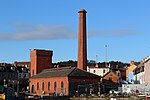Church of Holy Trinity, Hotwells
1830 establishments in England19th-century Church of England church buildingsChurch of England church buildings in BristolChurches completed in 1829Diocese of Bristol ... and 3 more
Georgian architecture in BristolGrade II* listed churches in BristolUse British English from February 2023

Church of Holy Trinity is an Anglican church in Hotwells, Bristol, England. It has been designated as a grade II* listed building.
Excerpt from the Wikipedia article Church of Holy Trinity, Hotwells (License: CC BY-SA 3.0, Authors, Images).Church of Holy Trinity, Hotwells
Charles Place, Bristol Hotwells
Geographical coordinates (GPS) Address Nearby Places Show on map
Geographical coordinates (GPS)
| Latitude | Longitude |
|---|---|
| N 51.4498 ° | E -2.6187 ° |
Address
Charles Place 9
BS8 4SD Bristol, Hotwells
England, United Kingdom
Open on Google Maps










